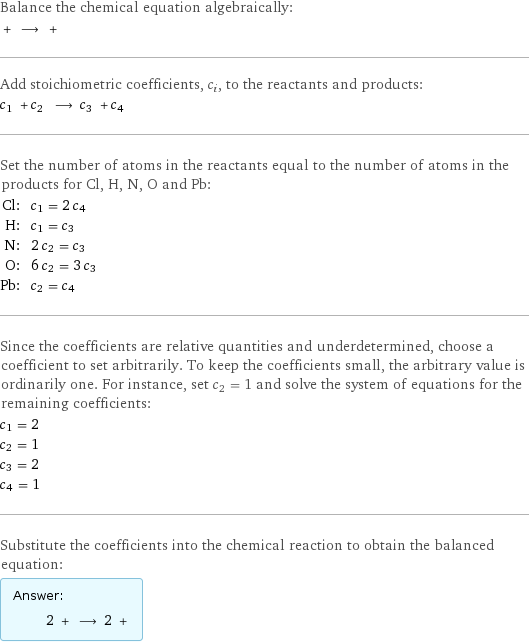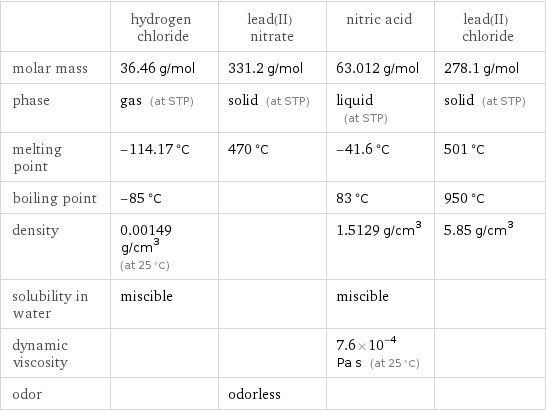Input interpretation

hydrogen chloride + lead(II) nitrate ⟶ nitric acid + lead(II) chloride
Balanced equation

Balance the chemical equation algebraically: + ⟶ + Add stoichiometric coefficients, c_i, to the reactants and products: c_1 + c_2 ⟶ c_3 + c_4 Set the number of atoms in the reactants equal to the number of atoms in the products for Cl, H, N, O and Pb: Cl: | c_1 = 2 c_4 H: | c_1 = c_3 N: | 2 c_2 = c_3 O: | 6 c_2 = 3 c_3 Pb: | c_2 = c_4 Since the coefficients are relative quantities and underdetermined, choose a coefficient to set arbitrarily. To keep the coefficients small, the arbitrary value is ordinarily one. For instance, set c_2 = 1 and solve the system of equations for the remaining coefficients: c_1 = 2 c_2 = 1 c_3 = 2 c_4 = 1 Substitute the coefficients into the chemical reaction to obtain the balanced equation: Answer: | | 2 + ⟶ 2 +
Structures

+ ⟶ +
Names

hydrogen chloride + lead(II) nitrate ⟶ nitric acid + lead(II) chloride
Chemical names and formulas

| hydrogen chloride | lead(II) nitrate | nitric acid | lead(II) chloride Hill formula | ClH | N_2O_6Pb | HNO_3 | Cl_2Pb name | hydrogen chloride | lead(II) nitrate | nitric acid | lead(II) chloride IUPAC name | hydrogen chloride | plumbous dinitrate | nitric acid | dichlorolead
Substance properties

| hydrogen chloride | lead(II) nitrate | nitric acid | lead(II) chloride molar mass | 36.46 g/mol | 331.2 g/mol | 63.012 g/mol | 278.1 g/mol phase | gas (at STP) | solid (at STP) | liquid (at STP) | solid (at STP) melting point | -114.17 °C | 470 °C | -41.6 °C | 501 °C boiling point | -85 °C | | 83 °C | 950 °C density | 0.00149 g/cm^3 (at 25 °C) | | 1.5129 g/cm^3 | 5.85 g/cm^3 solubility in water | miscible | | miscible | dynamic viscosity | | | 7.6×10^-4 Pa s (at 25 °C) | odor | | odorless | |
Units
